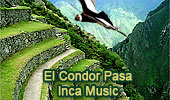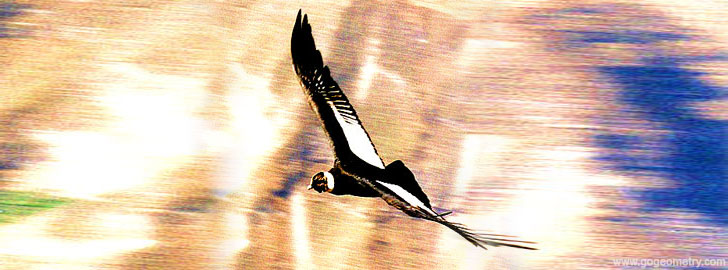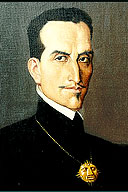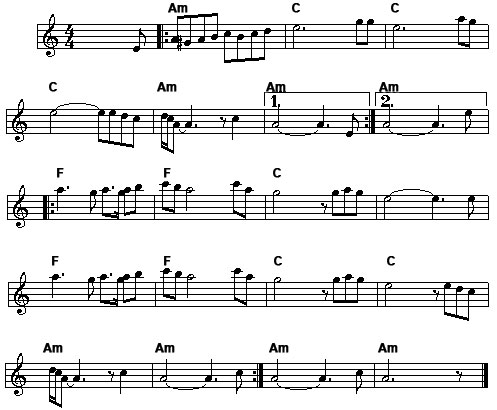Inca and Pre-Inca Music: El Condor Pasa,�The Flight of the Condor
 Peruvian music and geometry have a rich history that
dates back to the Inca and pre-Inca civilizations. The Inca
Empire, which existed from the 13th to the 16th century, was
known for its highly developed music, which played an
important role in religious and social ceremonies. Peruvian music and geometry have a rich history that
dates back to the Inca and pre-Inca civilizations. The Inca
Empire, which existed from the 13th to the 16th century, was
known for its highly developed music, which played an
important role in religious and social ceremonies.
Inca
music was based on pentatonic scales, with instruments such
as the quena (a type of flute), panpipes, and drums being
commonly used. In addition to traditional instruments, the
Inca also used natural sounds such as the chirping of birds
and the sound of wind to create music. The music was often
accompanied by singing, with lyrics in the Quechua language.
In terms of geometry, the Inca were skilled architects and
engineers, using precise mathematical principles in the
construction of their buildings and roads. They used a
system of knotted strings called quipus to keep track of
important information such as taxes and census data.
Prior to the Inca, the pre-Inca civilizations of Peru also
had a rich tradition of music and geometry. The Moche
civilization, which existed from the 1st to the 8th century,
created intricate pottery designs that incorporated
geometric shapes such as triangles and circles. The Nazca
civilization, which existed from the 1st to the 6th century,
created large-scale geoglyphs that also incorporated
geometric shapes and patterns.
In terms of music, the
pre-Inca civilizations used a variety of instruments,
including panpipes, drums, and flutes. They also
incorporated singing into their music, often using
call-and-response patterns.
Overall, the Inca and
pre-Inca civilizations of Peru had a deep appreciation for
music and geometry, using these art forms to express their
beliefs and values and to create beautiful and functional
works of art and architecture.

"El Condor Pasa", see an example of the
sheet music or a
video, is a typical Inca dance, based on authentic Incan folk
melodies. Around 1916, Peruvian composer Daniel Alomia Robles
notated this popular traditional melody and used it as the basis
for an instrumental suite. The English Lyrics, 'If I could, I
surely would' words, are by Paul Simon (Simon & Garfunkel)!
The Andean Condor is the world's largest bird
of prey that lives in the mountains, The adult height of
this enormous bird is four feet, and it has a wing span of 10
feet. It usually weighs between 20 to 25 pounds. The Andean
Condor�s cousin is the California Condor.
"Inca music often accompanied
ritualized religious dancing. Musicians used repetitive rhythms
and dissonant tones to induce an almost hypnotic state in the
dancers. Inca instruments were made of wood, reeds, pottery,
bone, shell, and metal. The Incas played two basic kinds of
instruments: wind and percussion. Wind instruments, such as
horns and flutes, produce a sound when a musician blows into a
tube or hollow chamber. Percussion instruments, such as bells or
drums, produce a sound when a musician strikes the instrument.
Drums and flutes were the most common instruments used by the
Incas. Flutes came in many varieties. The panpipe�a series of
cane or pottery flutes tuned to different notes and tied
together in a row�are still common in the Andes today." MSN
Encarta.
Inca Music according to Inca
Garcilaso de la Vega
Inca Music: The
New York Times 1920
El Condor Pasa:
Lyrics
El Condor Pasa:
Music Sheet
El Condor Pasa: Index
Inca Music:
from the writings of Inca Garcilaso
de la Vega (1609)
 "The Colla Indians and all those in
their district had a certain knowledge of music. They played
reed or cane instruments, made by joining four or five tubes
together, each one of which furnished a higher or lower note
than the preceding one, as in the case of organ pipes. There
existed four such instruments, each keyed to a higher or lower
scale, in the same way as the four human voices: soprano, tenor,
contralto, and bass. "The Colla Indians and all those in
their district had a certain knowledge of music. They played
reed or cane instruments, made by joining four or five tubes
together, each one of which furnished a higher or lower note
than the preceding one, as in the case of organ pipes. There
existed four such instruments, each keyed to a higher or lower
scale, in the same way as the four human voices: soprano, tenor,
contralto, and bass.
When one Indian played, a second
answered him, shall we say, in fifths, then a third on another
harmony, and the fourth on still another, each one in time.
These were professional musicians, who practiced in order to
give concerts for the king and nobles of the Empire.
They also had flutes with four or
five holes, like those played by shepherds. But since these were
never played on in concerts, each player carved his own in his
own manner, according to what suited him best. With this flute
he accompanied his love songs, which recounted, in even meters,
the favors or disfavors of his ladylove.
In the year 1560, when I left Peru,
there were five Indians in Cuzco who played the flute so well
that they could interpret any piece of organ music you put
before them; and today, in 1562, I am told there still exists a
considerable number of excellent musicians." The Royal
Commentaries of the Inca, Garcilaso de la Vega, 1609. Book II.
Inca Garcilaso de la Vega
(1539-1616) Peruvian-born Spanish soldier, historian, and
translator. The son of an Inca princess, he vividly retold
Peruvian history and folklore in his Comentarios Reales
(1609).
Music of the Incas. The New York
Times. Published: January 18, 1920
Carlos Valderrama, a Peruvian pianist and composer, will present some original folk music of South America at his first public appearance here on
Wednesday afternoon in Carnegie Hall.
"Inca music," he explained yesterday, " is the natural melody of s great, lost race of Americans, telling the story of their joys and sufferings. To find it I went to the placed where thousands of native Peruvians retreated in the days of the Spanish
invasion which destroyed the civilization of the Incas."
Senor Valderrama was born in Trujillo. Peru, and :knew of the existence of this music, for generations sung only by savages in their remote villages. To these he journeyed.
He had a guide to take him to the first two tribes, but after that ye went by himself through the almost impenetrable forests. "where one might
travel for weeks without seeing the sun."
At every village he persuaded the Indians to play for him their tribal music. Inca
music, he said is based on only five notes, played on hollow bamboo rods resembling flutes but yards in length. As the natives play the sound for miles in the high Andes.
El Condor Pasa Lyrics: Quechua,
Spanish, English
El Condor asa
A folk lyrics version from the
Quechua, the official language of the Inca Empire:
Oh mighty Condor owner of the
skies
take me home, up into the Andes,
Oh mighty Condor.
I want go back to my native place to be
with
my Inca brothers,
that is what I miss the most, Oh mighty
Condor.
Wait for me in Cuzco, in the main plaza,
so we can take a walk
in Machu Picchu and Huayna-Picchu
|
El Condor Pasa (If I Could)
Lyrics by Simon
& Garfunkel
I'd rather be a
sparrow than a snail.
Yes, I would.
If I could,
I surely would.
I'd rather be a hammer than a nail.
Yes, I would.
If I only could,
I surely would.
Away, I'd rather sail away
Like a swan that's here and gone.
A man gets tied up to the ground.
He gives the world
Its saddest sound,
Its saddest sound.
I'd rather be a forest than a street.
Yes, I would.
If I could,
I surely would.
I'd rather feel the earth beneath my feet.
Yes, I would.
If I only could,
I surely would.
|
El Condor Pasa (Si pudiera)
Letra de Simon &
Garfunkel
Spanish version
Preferir�a ser un
gorri�n que un caracol.
S�, lo har�a.
Si pudiera,
Seguramente lo har�a.
Preferir�a ser un martillo que un clavo.
S�, lo har�a.
Si tan s�lo pudiera,
Seguramente lo har�a.
Lejos, preferir�a navegar lejos
Como un cisne que est� aqu� y se fue.
Un hombre est� amarrado a la tierra.
Le da al mundo
Su sonido m�s triste,
Su sonido m�s triste.
Preferir�a ser un bosque que una calle.
S�, lo har�a.
Si pudiera,
Seguramente lo har�a.
Preferir�a sentir la tierra bajo mis pies.
S�, lo har�a.
SSi tan s�lo pudiera,
Seguramente lo har�a. |
The lyrics are copyright by
their respective owners. They are used here for educational
purposes only.
El Condor Pasa: Sheet Music
Example of Sheet Music
El Condor Pasa
by
Daniel Alomia Roble

|